Don't wanna be here? Send us removal request.
Text
Bam. And the assignment's finished.
It's my last post time! Time for my last post! Last post!
How exciting. Thanks for sticking around (Anthony Collins, I'm looking at you) for all the trials and tribulations. The excitement of the art work from Darwin, the lack of posts for several weeks, the anger, the minor swearing (sorry about that, but really sometimes things just come out that way, it's for the best) and the good bits too. I've come to the end now, the course has finished and all I have left to hand in is my major assignment. I've strayed a little from the suggested topics, but I'm pleased that I've looked into something that interests me.
For this last blog entry I'm going to take things down a notch. Keep it simple, and talk about a couple of Indigenous art pieces that are closer to home, literally. I'm getting up close to the art, getting in it's face, messing it up (not really) and actually interacting with it.
The first piece I'm looking at is a painting that my cousin Libby gave to me for my eighteenth birthday. Libby lives in London with her partner Jay, and I mentioned her very briefly in my last post. Jay is Aden Ridgeway's (the politician, though I'm sure you knew that) son. Jay and Libby met when she was working (she's some kind of lawyer something) for his father during one of the elections in the last decade, and they've been dating (aw, is there not a better word for that?) since. They packed up and moved to London, but still kept strong connections to home. My eighteenth birthday present was really getting to see Libby, who'd travelled for 26 hours on a flight to Adelaide, but she had presents too, so it was double-y good.
This is the painting she gave me:
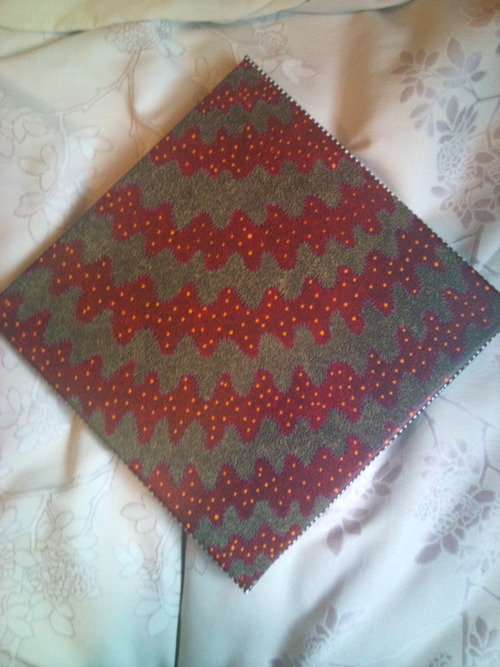
It's a dot painting (obviously) and the strings at the back are kind of crossed over, so I believe you're supposed to display it as a diamond rather than a square. I don't know if any of that made sense, but yeah, that's all I got. On the back of it it says 'THELMA DIXON', so I assume she's the artist responsible. It also says 'Ruby Salt Bush' in parenthesis under another word, that I can't quite make out, which I believe to be the Aboriginal translation. It's also been stamped with 'Mbantua Gallery', which I've just now googled and appears to be quite prominent. http://www.mbantua.com.au/
I went crazy for this piece when I opened it. It may have been the alcohol, but I stared at it for a good half an hour and then continued to talk about it for a lengthy period during my birthday dinner. It hangs on my wall now and I find it thoroughly delightful. My favourite part of it is the red. Just the red. I really like red.
The very, very last piece I'm going to post is something that has recently popped up in my neighbourhood. I watched some workmen putting it up on the corner of an intersection near Glanville, where Semaphore road begins. I have almost no idea what it is, but I went on an exploration and took some photos, so maybe you'll know:
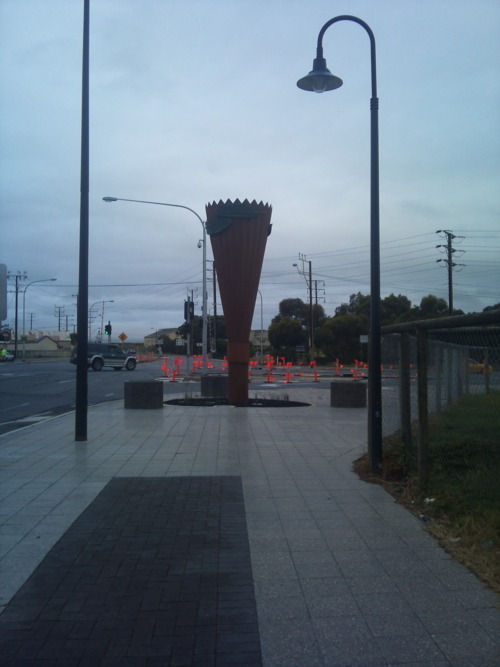
I apologise for the darkness of the pictures, but it was a grey day and.. I don't control the weather.
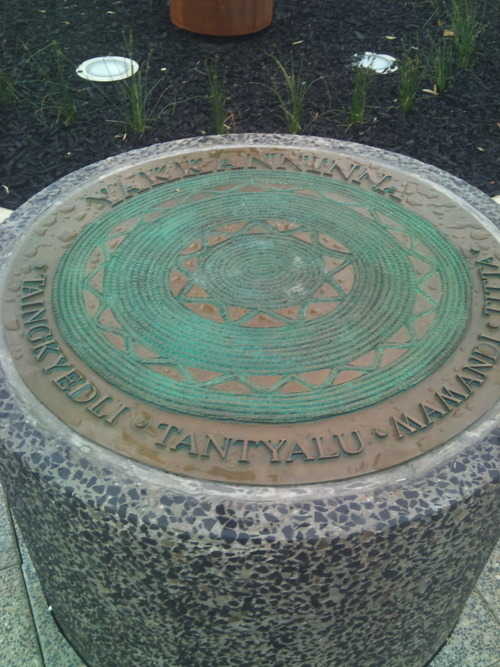
There are three of these stone, cylindrical columns surrounding the base of what looks to me like a giant torch with eucalyptus leaves. They each say something different on them, so rest assured I'm not posting the same image three times.
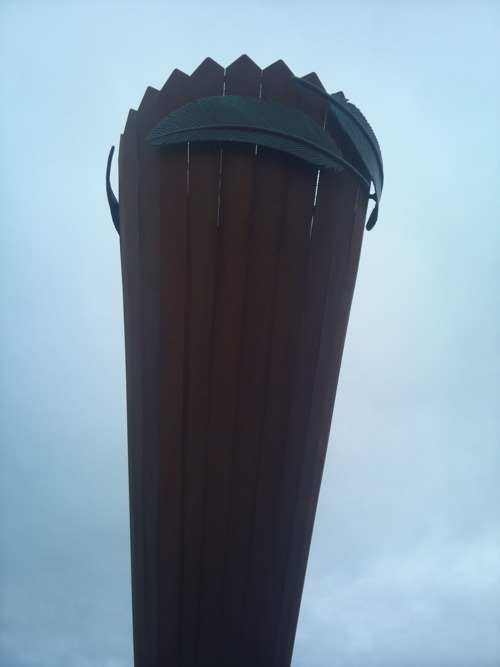
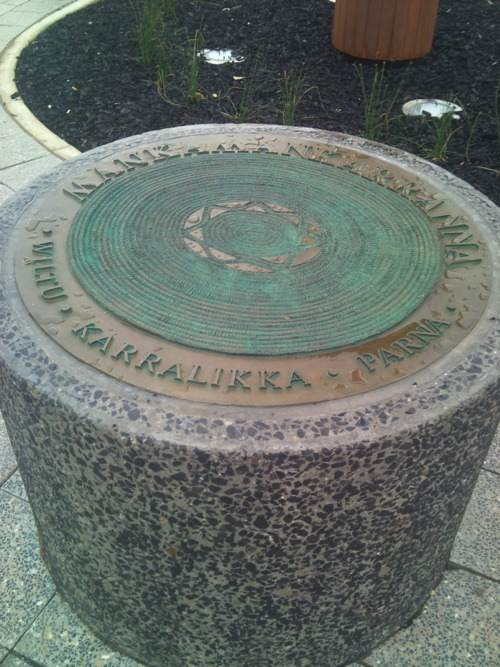
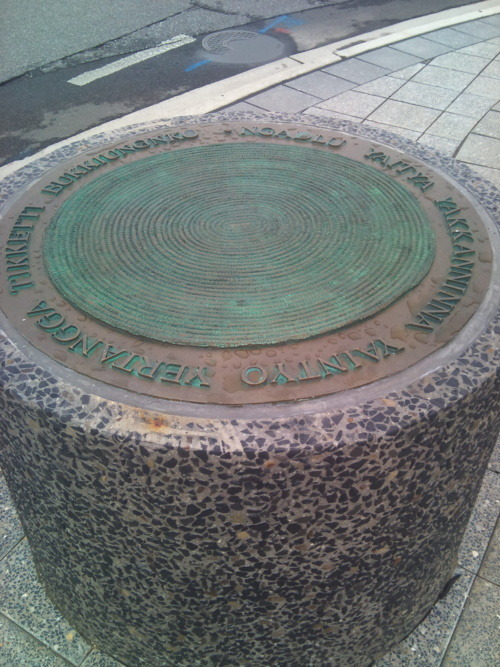
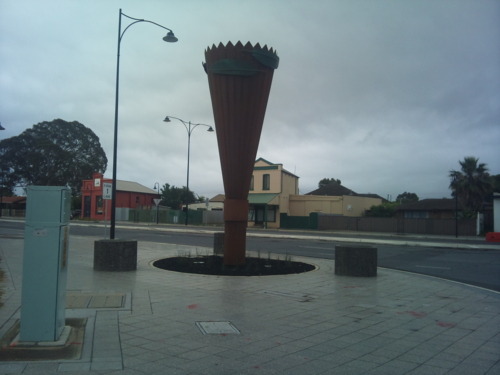
I haven't been able to construct a 'deeper meaning' of this work yet. At the moment, I feel like it's something that is commemorating the land, or that this part of Adelaide has particularly strong Aboriginal connections (that seems wrong, but Port Adelaide is nearby). Maybe Semaphore just needed some sprucing up, or the Arts sector of the Government had some money to spare and offered a grant to someone, anyone who could come up with something relevant to this part of the world. And this is it.
It was a little perplexing at first. Where did it come from? Why is it here? Who? What? When? How? I quite like it now. Just accepting it into the landscape. Maybe I'll drive past it one day and it'll all make sense, but until then I'm happy to just appreciate it as something an artist, somewhere, has come up with. It's good.
That was a nice conclusion, yes? I think it's worked well. This was a good assignment, connected with the youth (we who struggle with the most simplest of tasks) on many levels I think. It got me thinking. It made me angry. And it made me more considerate. Yes, it was a success.
Signing off for the last time,
PHOEBE GUNN.
110046917
0 notes
Text
A little less conversation, a little more action
Bam. And I'm back.
Thursday is tutorial day for me in this subject, and it was an interesting one this week. We had a small debate. A debate date. It wasn't quite a debate. We were just invited to share our thoughts and perhaps, even put a little thought into forming an arguement from our side of the fence, on the topic of people buying and hanging Aboriginal artwork in their homes and galleries. The arguing point was that we (non-Aboringinal) cannot truly appreciate the work, because we aren't part of the culture. It's true, for sure, no one can understand any artwork 'truly', but it's not going to stop people from buying it, and it's not going to stop people from trying to learn from it. And as long as we are learning from it, then why not? Trying to prohibit learning is pretty unjust.
Money was another major element. If you put your work up for sale, then the person who buys it then holds the rights to it. To put it where they want and see it how they want, regardless of culture. I feel that, and I stick to that. If you want to profit from your work, then you have to be willing to except that someone who doesn't 'understand' the work will buy it. And embrace it. Embrace that someone will be learning from it. Aaaand we're back to learning. Learning, it's pretty excellent.
What worries me a little about the money point, is that seeing art only as a money-making venture downgrades the quality and integrity of the art. This is a big deal and it goes for everyone selling their art. Art is a big deal, it's YOU, manifested through a medium. For some it's their history and their religion, a form of expression and for others it's just for a laugh. But whatever way you look at it, for some it's a way of making a living. And it DOESN'T MATTER what's on the canvas or in the photo or how the clay is thrown, as long as someone will buy it and you can eat for the next week or so. Urgh. I really struggle with this. With seeing people's art as a commodity and potentially seeing my art as that too. It exists though, and if we don't stare it in the eye and trying to understand or learn from it, then we'll become victims to it. Though, I can't help but think we already are.
Ah, capitalism. Good for you.
Anyway, there were a lot of thoughts. It was a big thought filled mess. But without the big. And without the mess. Just thoughts. No-one really came out of their shells, and just blasted their stand point. That would've made things a bit more interesting, but probably not as enjoyable. And it's hard to leave the warmth and comfort (or something) of your own mind sometimes and just spill it out in front of people you don't really know, so I think we did alright.
What ultimately dawned on me, was that there was a problem with calling Aboriginal art.. 'art'. It's not 'just art'. It's history, and a form of documentation. It's higher than 'art'. But it's up to people to realise that, and we can't force them to see it like that. They have to do it on their own.
Also, what's up with Imants Tillers? I really dislike that guy. He just doesn't get it.
This post kinda got totally out of hand, but I think I needed to digest some of the information that I took in on Thursday. We were given a quest at the end of class though, which is just magnificent. And I mean that sincerely. I love quests. We have to visit the Flinders Gallery in the State Library and check out the hip haps (translation: 'happenings') of that exhibitions.
Wow. I got so off track. I was going to write about my b and c points from the previous post. Ah well, I'll get to it in due time. Stay tuned!
0 notes
Text
Excitement.
So much excitement. Things to write about! How great!
Ok, so yesterday my parents got back from Darwin, where they had been holidaying, and with them they brought some excellent stories. Generally, the stories involved crocodiles and aeroplanes, but what I found most interested was that they had a) been to the Telstra national Aboriginal & Torres Strait Islander art awards/exhibitions, b) brought me Indigenous art themed gifts and c) actually bought a painting by Glen Namundja, who won the Telstra Bark Painting award in 2010 and the $4000 Telstra Works on Paper award in 2009. THEY BOUGHT ONE OF HIS BARK PAINTINGS. Excitement, right?
I'm going to try and communicate my excitement on each of the previous things now. It might be a struggle.
So. A) They got to check out all the work from this extraordinary exhibition, and my mum even spoke to some of the artists. I might see if I can get her to tell me some more. While they were still away, mum sent me a booklet with the pieces by the winners and a list of all the entries, and the sales information booklet (some kind of hint, maybe? bit out of my reach in terms of money, sorry mum). It was fantastic to see the works on paper (even if it's still not in 'real life'), instead of looking at them on a screen. The ultimate winner, Dickie Minyintiri's piece Kanyalakutjina (Euro Tracks), synthetic polymer paint on canvas, struck as being extraordinarily bright. From the Indigenous works I've seen so far in my life (the number is small), what usually strikes me is the darkness. Dark colours, with highlights of white. But this, this is bright. And it looks so jubilant. The accompanying write-up of the pieces says that the painting shows the tracks of animals walking up to the waterhole in the country that Dickie is responsible for. I feel that. The brightness, the life of the painting, is shown through the animals all going to the waterhole, a place that ensures that life continues. This painting shows a journey and maps the responsibility Dickie has for his land and all things that are a part of it. That's real beauty:
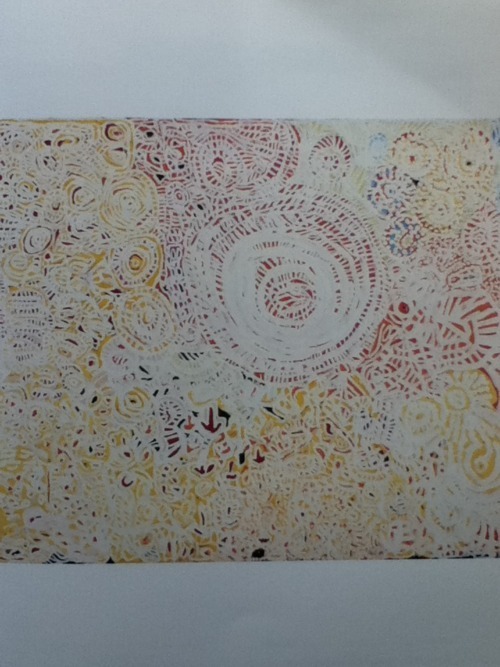
The other pieces that caught my eyewere the Wandjuk Marika Memorial 3D Award and the Telstra New Media Award. It seems very contemporary to include 3D and New Media, but very relevant. And perhaps, from my art student perspective, a way to incorporate the new with the old. The 3D awards was won by Gali Yalkarriwuy Gurruwiwi, Banumbirr (Morning Star poles):
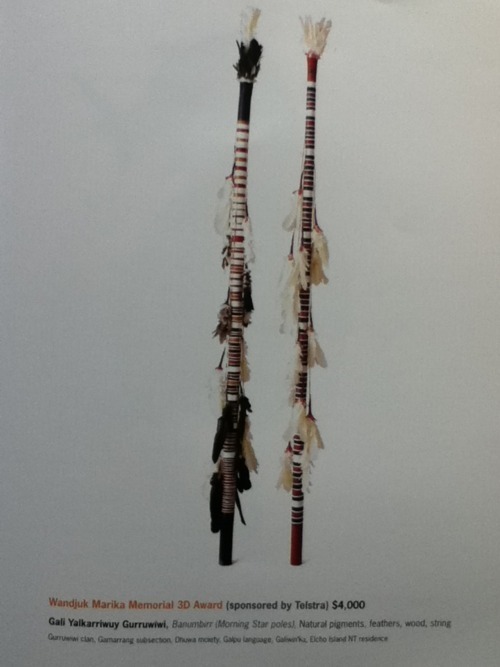
And the New Media award went the Ricardo Idagi, Upi mop le - Tail end man:
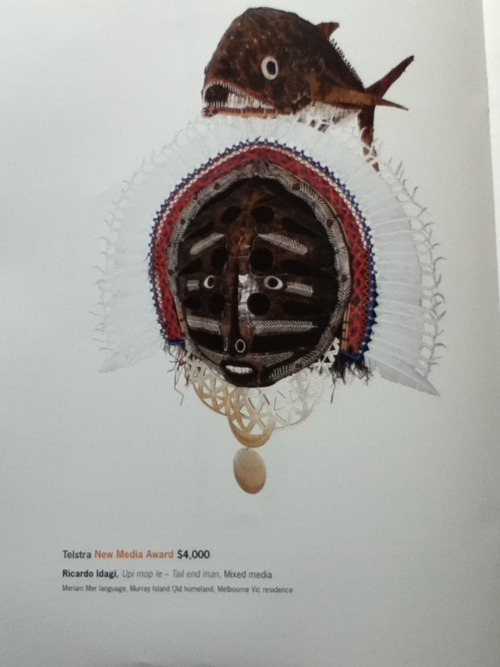
Well, that post was a bit longer than I expected it to be, but why the heck not. I think I'll make separate posts for my points on b and c, give me time to digest the excitement a little more. There is a lot of it.
1 note
·
View note
Text
I have 'reblogged' some pictures. The 'reblog' function of Tumblr is.. great? Useful? Ingenious? Pointless? Shameful? You basically take everyone elses ideas and use them to represent yourself. You take little pieces of people and they take little pieces of you and together you prove that.. Everyone is actually the same. Just made up differently.
I thought I'd have a quick hunt for pictures that might relate to this assignment. I searched 'Papunya Tula', which turned up one result. ONE. That was actually better than I'd expected. Then I searched 'Aboriginal Art', which came up with a lot more. There were blogs people had written, pictures of art, pictures of Aboriginal models, cave paintings.. There was a lot. I picked a few and reblogged.
Now I've done that, I'm getting the feeling that I might have to contribute something as well. Maybe see if I can get 'reblogged'. To see if someone will find something I've posted and feel that it, in some way, connects to them. And use it. For their own personal gain. Hmm. An adventure is on the horizon! ..Sort of.
1 note
·
View note
Photo
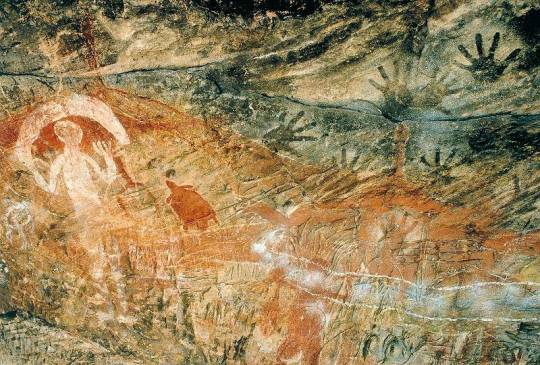
37 notes
·
View notes
Photo
bombasi:
Gracie Ngala Morton Pwerle

12 notes
·
View notes
Photo
anettee:
© Alma Nungarrayi Granites, Warlukurlangu Artists
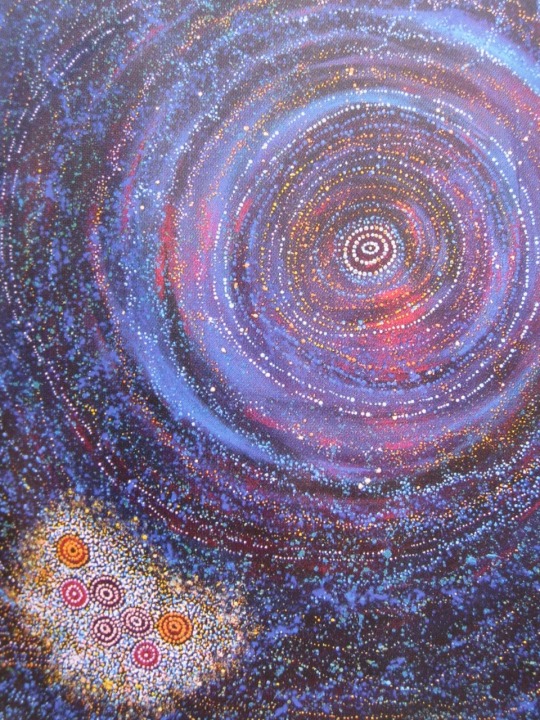
64 notes
·
View notes
Photo
artpropelled:
Paddy Bedford, Dingo Dreaming, 2001, ochre on canvas, 122 x 135cm. Corrigan Collection. (Courtesy Jirrawun Aboriginal Art Corporation and the Corrigan Collection).
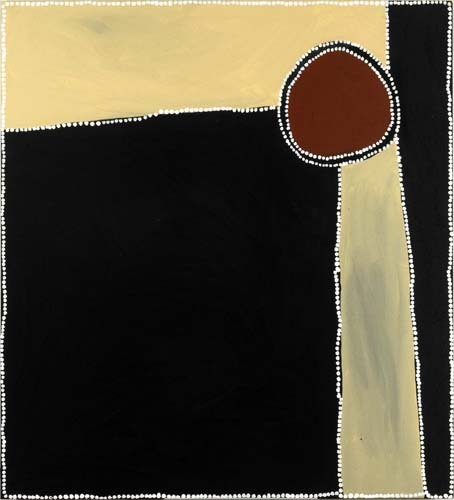
71 notes
·
View notes
Photo
artpropelled:
Australian Aboriginal Art
Artist unknown
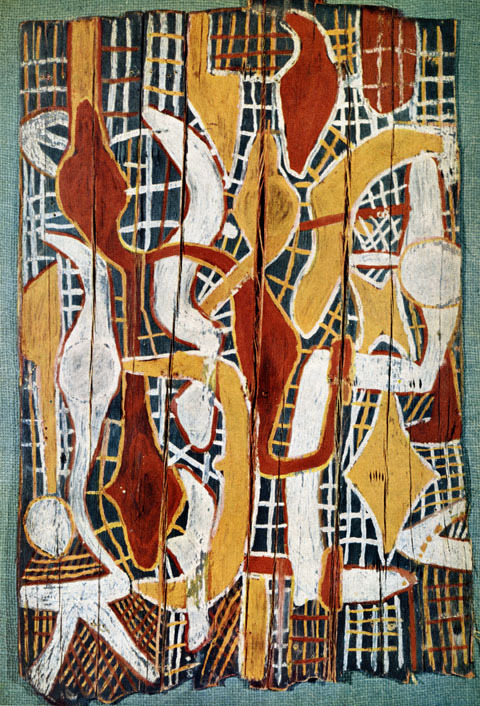
51 notes
·
View notes
Photo
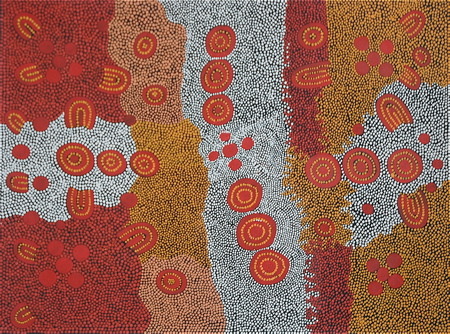
18 notes
·
View notes
Text
Starting something.
I finally read through the course booklet and realised that I'm actually supposed to play online for this assessment. Good job UniSA Art, Architecture and Design school for making an assignment that will appeal to the youth of the course. Seriously though, this is decent. I don't know how the 'mature age' students will hang with it, but it's a learning experience nonetheless.
Last week I submitted my first assignment (I did my write up on Papunya Tula: Genesis and Genius, which was awesome for the record) for this course and my gosh.. It was not..
You know, I don't know how much of this should be admitting. Or omitting rather. I'm being assessed on this, yeah? Perhaps, I'll keep some things on the down low. This is for school. Learning. Heaven forbid I make it personal!
Anyway, I'm going to try and suss some exhibitions in Adelaide, find me something to write about on this page. The 'scene' seems to be dominated by Saatchi at the moment, and the White Rabbit, but all the more reason for an adventure I say.
Congratulations once again UniSA, I'm stoked for this assignment. Look, I'm being studious:
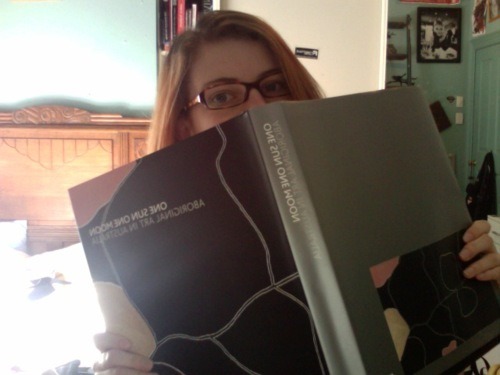
Side note.
I totally just opened to a random page, and stumbled upon this painting of awesomeness. Willie Gudabi, Singing Ready for Ceremony, 1992:
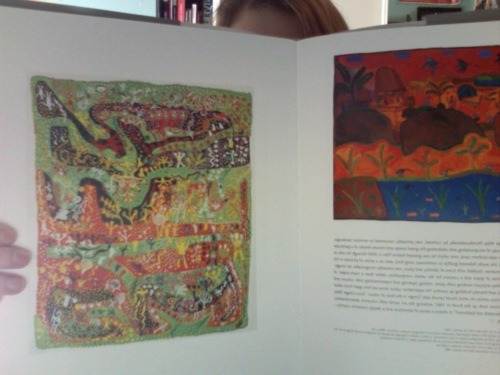
0 notes